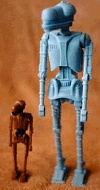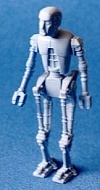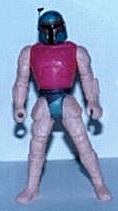
The Blue Harvest
By Chris Georgoulias

Production EV-9D9 with 2up "Blue Harvest"
hardcopy
(courtesy The Star Wars Collector's Archive)
Fake and/or Reproduction Prototypes - The Real "Blue Harvest"
|
Welcome now to what a few of us refer to as the "Blue Harvest" of the 1990's. It's the deluge of blue colored vintage "prototypes" that have flooded the market during the past 2-3 years. This deals strictly with the hard copy figures so if you're a bit unclear on hard copies I suggest re-reading that section. The urethane resins that Kenner used to make Star Wars hard copies from 1977-1986 varied in color and composition. Colors ranged from tan to gray to green and a couple more oddballs thrown in for good measure. However, green is the most frequently seen color for vintage Star Wars hard copies. The big deal with "blue" is that Kenner did not use this type of urethane to make hard copies until 1989 and this fact has been confirmed by a knowledgeable Kenner employee. This means that any hard copy of a vintage Star Wars piece (remember the old Star Wars line died in 1986) that is made of the blue urethane is a reproduction (i.e. it's not a legitimate original piece). Read that sentence again. Granted a blue piece may have come from the original silicone molds that Kenner used to pull hard copies from, but it's date of manufacture doesn't jive with it's supposed history. These things appear to have been cranked out when the Star Wars hype resurged in around 1994 or so and are possibly still being cranked out. |
| The most frequently seen blue pieces are the 4-up Micro Collection figures. The original sculptings and silicone molds were all 4:1 and it wasn't until the steel mold making process that they were scaled down to their proper (1:1) size. This means that any "large" prototype micro figure had to come from the original silicone molds. However, it's entirely possible that new molds were made from existing hard copies so that more could be cranked out by the bad guys. It's hard to believe, because of material degradation over time, but the original silicone molds are supposedly still in the Kenner archives. This was confirmed by Steve Sansweet who saw them firsthand. If the Blue Harvest was indeed made at Kenner from these molds then making them posed no great challenge because all the materials were almost effortlessly at hand. Is it a legitimate prototype from over a decade ago? No it's not, for the simple reason that Kenner didn't use this material during that time period. Is it a representative of the prototype piece? Yes it is, and this is an important fact to consider. However, if the blue piece is being pushed as a legitimate prototype (at a high price) then one must consider that he is potentially throwing away his money because the authenticity of the piece is shot. These blue castings amount to nice, albeit limited, reproductions, but they are reproductions nonetheless. Because of their enormous expense, steel molds are not created for items that are out of their production scale making it impossible to produce an injection-molded plastic version of a 4-up. This is an extremely important piece of information to remember as many people find it hard to tell the difference between some plastics and the blue urethane, though you don't have to spot the difference if you can just remember the process. |
|
Other oddball action figures and accessories have turned up in this blue urethane and it's important to note that the same rule applies to them. If it's a Star Wars toy that's from 1986 or earlier, and blue, then it cannot be an authentic hard copy - it's just a reproduction.
People sometimes confuse the blue urethane with regular plastic because it has a similar feel to it. However, the blue material is very hard and doesn't have the flex that regular plastic does. Especially on older Star Wars hard copies, the urethane is very heavy compared to plastic which is a dead giveaway. It's so hard that it almost feels like ceramic pottery. Unfortunately, the newer, blue material is much lighter than the old urethane resins and makes it harder for the novice to quickly differentiate from regular injection-molded plastic. This can be a point of confusion, but the good thing here is that one can know what they are looking at, not by the material, but by the piece itself. If it's a Micro Collection 4-up then it cannot be (injection molded) "plastic" because those were not made from steel molds. Likewise, if the figure you are looking at has no dates on the legs, no holes in the feet, and is assembled with pins in the joints, then it's made of resin because it's a hard copy.
Blue plastic is OK, but blue urethane is not. The urethane unfortunately looks like blue plastic sometimes so the best way to tell if it's a first shot is to see if it is assembled like a production figure. This means that it has "built-in" joints, etc. It doesn't have to be ultrasonically welded together either. As long as the pieces all fit in there and it could be welded to properly function is all that matters.
Other Confusing Prototypes
Another problem with some "older" prototypes are the 1977 vehicle "first shots" that are floating around and are made of various colors. While they look like legitimate old items, they are in fact first shots made when Kenner was ramping up for Star Wars again in the mid 1990's. These were cast in the original steel molds before the 1977 copyright dates (in the molds) were changed to reflect the new 1995 copyrights. This can be easily verified by looking at how the copyright dates appear on the newer toys because the metal was removed from the mold and the new dates inserted. When you remove steel from a mold, you are essentially adding plastic. The Landspeeder copyrights, for instance, are molded on top of a raised area in the plastic. You can also tell that these things are new because they're so darned white! White plastic ships like this would certainly show some signs of age after 20 years. This phenomenon also goes for the C-3PO carrying case whose "milky-white" prototypes turns up quite frequently. These things are basically the plain toys molded in odd colors. If items like this intrigue you then that's fantastic, but you have to remember that they were not part of the pre-production process of the old Star Wars toy line.
Prototypes of Post-1990 Action Figures
|
A plus side to the blue urethane material is that it's a much better material to make hard copies from. This is undoubtedly the reason Kenner switched from the old, more brittle and heavier materials of the past. The blue stuff is tough and has a nice finish when it has set. Because the blue is widely used now, the hard copies for today's Star Wars figures are made from it. While this might sound fantastic to some (as they don't have to "worry" about blue fakes), it comes across as more frustrating to others. Now there is no way to tell if the piece is a legitimate prototype or if it is one of any number of cheap reproductions that can be made. Material-wise and chronologically there may be little or no difference, but when you get down to the principles of the matter then there is a major difference. |
| Hard Copies for the Action Masters figures have turned up quite often recently - relatively speaking, of course. The style of these closely resembles the old Micro Collection figures, but the Action Masters were sculpted at a 2:1 ratio (not 4:1) making these hard copies "2-ups". |
|
First shots of the new action figure line are quite common - for prototypes that is. It's so easy to crank out lots (or save lots) of them that tons have flooded the market. They almost surpass the term "prototype" as they are more like a limited run of some odd-colored production figure. When so many of the same thing enter the collector's market, the mystique that draws people to them in the first place is kind of lost. Prototypes sort of lose their meaning when several hundred are floating around.




